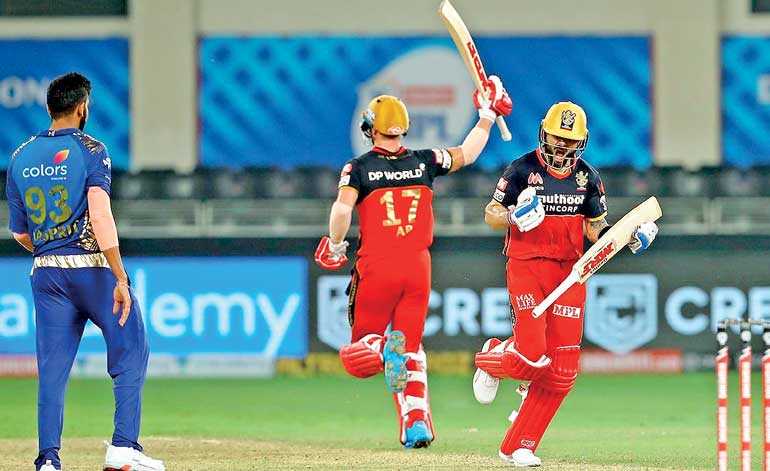Friday Oct 31, 2025
Friday Oct 31, 2025
Tuesday, 3 November 2020 00:10 - - {{hitsCtrl.values.hits}}

IPL 2020 is an example of how a business could adapt in challenging times
COVID-19 doesn’t spare anyone, they say – irrespective of one’s status. Sports had to take a severe beating this year due to it. The summer Olympics had to be postponed. The Wimbledon was cancelled. However, there’s one thing COVID-19 cannot beat: money and power, as the 13th edition of the India Premier League (IPL) currently taking place in United Arab Emirates (UAE) shows.
India is the financial superpower of the cricket world; 80% of the annual revenue of the International Cricket Council comes from India. The IPL, run by the Board of Control for Cricket in India (BCCI), is the biggest cricket league in the world. It’s now a global business, with an estimated $ 6.8 billion brand value. It has doubled the value during the past five years. IPL contributes to a lion’s share of BCCI’s annual revenue. 
The 13th edition of IPL was originally scheduled from March to May in 2020, but had to be postponed due to the COVID-19 outbreak, which has hit India pretty badly. India has the second highest number of COVID-19 cases in the world. In this backdrop, playing the IPL in front of packed stadiums in India any time in 2020 would have been unthinkable. But BCCI couldn’t afford to cancel the tournament in 2020 due to many reasons.
A cancellation of the cash-rich league would have resulted in a guaranteed loss of $ 530 million to BCCI in 2020. Disney-owned Star India secured IPL broadcast rights for five years from 2017 (beating Sony and Facebook) for a whopping $2.6 Bn. The revenue from broadcast rights and sponsorship revenue would have been lost if the event was cancelled.
The money generated from IPL is utilised for many projects, including the development of the game and building infrastructure. IPL shares 50% of all sponsorship rights with the eight franchises. Each of the eight franchises would have also lost over $ 40 million if the event was cancelled. The franchises would also miss out on gate money as well as in-stadium revenue. The current sponsors would demand discounts without the fans.
IPL draws top cricketers from the world. By playing just one IPL season (lasting about 55 days), some international players stand to earn more money than they could potentially earn from their Boards during their entire careers! Also, there are so many lesser-known Indian cricketers. All these players would have lost their valuable earnings.
Cricket associations hosting a match gets around 50 crores. Also the event management companies are paid around 25 crores each season.
If the IPL was cancelled, all these parties would have been hit hard.
It is estimated that cricket contributes to about 80% of all sports viewership in India. There was no cricket involving the Indian team for nearly seven months and depriving IPL to a cricket-crazy nation would have been a tragedy.
In this backdrop, the BCCI decided to host IPL in the UAE – in Dubai, Abu Dhabi and Sharjah. It was a wise choice, considering that UAE has great facilities and very good transportation links with the rest of the world. In fact, half of 2014 IPL season was also played in UAE.
However, there were many challenges.
It’s common knowledge that the IPL is tightly linked with entertainment. It would have been strange to hold IPL without the packed stadiums, cheer girls and all the extravaganza. Playing 60 matched in 53 days involving 500 persons in a massive bio-secure bubble across three cities amid a global pandemic was a gigantic task.
The logistics also added to costs; from charter flights to quarantining teams on arrival and then moving all members of the teams into a bio-secure bubble. This also included the support staff, umpires and other match officials, BCCI staff and several others. More than 20,000 COVID tests were to be carried out during the tournament. Could the bio-secure bubble be maintained during the entire tournament?
All matches are to be played in only three stadiums having two to three pitches, so these pitches are bound to wear out and take a beating. Also, 13 players and support staff of the Chennai team were tested positive initially, casting doubts on the sustenance of the tournament.
Add to this, the title sponsor Vivo pulled out from this year’s edition and the new sponsor Dream11 paid only $ 30.36 million, which is half of what Vivo paid.
The decision to play the matches in UAE was not a gamble, but a calculated risk. But BCCI was determined to go ahead. It took measures to slash the prize money awarded to the winner from Rs. 20 crores to 10. The cash price of the runner up was reduced to Rs. 6.25 crores.
As the tournament progressed, the results started to show. Playing the tournament close door in empty stadiums hasn’t affected the viewership at all!
As per BARC-Nielsen, an unprecedented 200 million people watched the opening match in the 2020 season between Mumbai Indians and Chennai Super Kings, which is considered to be the highest-ever opening day viewership for any sporting league in the world! The opening week of IPL 2020 saw a 15% growth in viewing minutes compared to 2019. After 41 matches, the IPL viewership is up by 28% in 2020 compared to 2019.
On live streaming via Hotstar, IPL 2020 has been watched by 269 million viewers, which is 11 million more per match compared to the same period in 2019.
The advertising volumes have also seen a 15% growth. Perhaps, the lock down due to COVID-19 has yielded excellent results!
On the field, the matches have been absorbing with many thrilling finishes. With just four matches to be completed in the league stage, only Mumbai Indians have cemented a place in the play offs.
IPL 2020 is another example of how a business could adapt in challenging times. Of course, having money and power certainly helps!
(Renuke is a cricket enthusiast. He can be reached via [email protected])